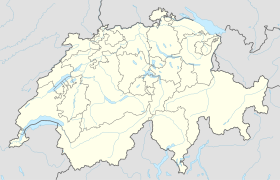Eat FR
| FR is the abbreviation for the canton of Friborg in Switzerland and is used to avoid confusion with other entries of the name Essert . |
| Eats | ||
|---|---|---|
| State : |
|
|
| Canton : |
|
|
| District : | Saane | |
| Municipality : | Le Mouret | |
| Postal code : | 1724 | |
| former BFS no. : | XXXX | |
| Coordinates : | 579 212 / 175829 | |
| Height : | 818 m above sea level M. | |
| Residents: | 259 (2002) | |
| map | ||
|
|
||
Essert ( Freiburger Patois ) is a town and formerly an independent political municipality in the Saane district of the canton of Friborg in Switzerland . The former German name Ried (or Oberried ) is only rarely used today. On January 1, 2003, Essert was merged with five other municipalities in the new municipality of Le Mouret . Essert is not to be confused with Oberried FR in the same municipality.
geography
Essert is 818 m above sea level. M. , eight kilometers south of the canton capital Friborg (beeline). The village extends in a promising location on a ledge above the valley of the Ruisseau du Pontet , on the eastern slope of the Bois Derrey , in the hill country at the northern foot of the Alps. The former municipality area was around 2.5 km². The area reached from the valley basin south of the Bois d'Amont over the forest hill Bois Derrey ( 886 m above sea level ) and the valley of the Ruisseau du Pontet up to the height at Montévraz (up to 945 m above sea level ).
population
With 259 inhabitants (2002), Essert was one of the small communities in the canton of Friborg before the merger. In 1870 the village had 192 inhabitants, in 1950 237 inhabitants. Essert also included a small part of the Le Mouret settlement, which used to be divided by numerous municipal boundaries. There are numerous individual farms in the area around Essert.
economy
Up until the second half of the 20th century, Essert was a predominantly agricultural village. The manufacture of straw hats was also widespread in the 19th century. Even today, dairy farming and cattle breeding and, to a lesser extent, arable farming play an important role in the income structure of the population. Some other jobs are available in local small businesses and in the service sector. In the last few decades the village has also developed into a residential community thanks to its attractive location. Many workers are therefore commuters who mainly work in the Freiburg region.
traffic
The village is located away from the major thoroughfares above the main road from Freiburg via La Roche to Bulle . The main access is from Le Mouret. Essert itself has no connection to the public transport network, but the buses on the Freiburg-La Roche-Bulle line stop on the main road below the village.
history
The place was first mentioned in a document in 1180 under the name Esserz . The current name has been attested since 1228 and the German version Ried since 1377 . The place name is derived from exsartum , the past participle of the late Latin word exsarire (to clear, to make arable).
Hauterive Monastery had owned land in the Essert area since the Middle Ages . In the course of the 15th century the village came under the rule of Freiburg and was assigned to the Old Landscape (Burgpanner). After the collapse of the Ancien Régime (1798), Essert belonged to the La Roche district during the Helvetic Republic and to the Friborg district from 1803 before it was incorporated into the Saane district in 1848 with the new cantonal constitution.
In 1996 the idea of a large-scale community merger was born. On June 13, 2002, the voters of Essert voted with a yes share of 92% for the merger. With effect from January 1, 2003, the previously independent municipalities of Essert (FR), Bonnefontaine , Montévraz , Oberried (FR) , Praroman and Zénauva were merged. The new parish was named Le Mouret .
Attractions
The Sainte-Anne village chapel was built in 1526. Ecclesiastically Essert belongs to the parish of Treyvaux . On the eastern side of the valley of the Ruisseau du Pontet is the Grande Riedera Castle, which was built in 1639, has a round stair tower, an enclosure wall and a castle chapel from the time it was built. The Grande Riedera has served as a cultural center since 1990, where exhibitions and conferences are held. There is also a dog museum there.


